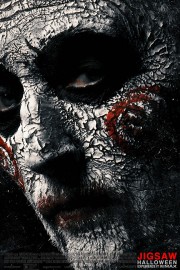Jigsaw
I never needed another “Saw” movie after 2010’s alleged “Final Chapter.” It was true before I walked in to “Jigsaw,” and it is true after watching “Jigsaw.” In all honestly, I found the “Saw” movies all consistently entertaining in how they went about their torture porn business, but I’ll be the first to admit, it really twisted itself in knots keeping the series going after John Kramer, the righteous cancer patient who became Jigsaw to punish those he found guilty of sins played by Tobin Bell, died in the third film…in 2006. In the five films since, the filmmakers have kept Jigsaw’s work alive through disciples he taught to continue the work. That last sentence contains a spoiler, I’ll admit, but it will make one keep on their toes during “Jigsaw,” and besides, the film already teases things along the way anyhow.
The film doesn’t start as we are used to a “Saw” film beginning. This one has a criminal on the run from the cops. He is cornered as he finds a trigger taped to a beam marked with an “X.” With guns on him, he asks for Detective Halloran (Callum Keith Rennie), who orders the cops to aim for the trigger. Most do, but not before he presses it, initiating the game for five people, although one person shoots him in the stomach, resulting in him being put in a coma. At that point, we move back-and-forth between the cops trying to discern the perp’s case, while we also see the tests the five are put through in a barn. Jigsaw’s voice is heard with the introduction of each game, but we thought he died long ago? Gradually, bodies make their way to the morgue, and Halloran tries to put the pieces together with his partner (Clé Bennett), a former Army doctor (Matt Passmore) who’s struggled with PTSD, and the doctor’s assistant (Hannah Emily Anderson), who has a macabre obsession with Jigsaw’s methods. Want to play a game as to what Halloran fixates on?
The screenplay by Pete Goldfinger and Josh Stolberg follows the “Saw” franchise playbook to the letter, with imaginative (and bloody) tests for each of the victims in the barn (Laura Vandervoort, Paul Braunstein, Mandela Van Peebles and Brittany Allen; the fifth one doesn’t make it past the first test) that directors Michael Spierig and Peter Spierig stage with all the subtlety and nuance of cinematography, editing and sound design we’ve come to expect from this franchise. At this point, the “Saw” franchise has gone beyond the humble police procedural thriller origins of the first two films and shares more in common with the “Friday the 13th” franchise- we’re just waiting to get to the next test to see how the next victim dies. I’ve always felt like, as a whole, “Saw” was more consistently solid in quality, not just for how it does things, but in the compelling morality at the dark heart of the series. Question- how many people has Jigsaw actually killed throughout the series? The body count is massive, but Jigsaw always gives those he traps a way to break free. Similarly, is he really killing innocent people? As the films move along, and the captives go through their tests, we learn of the sins they’ve committed, and that question is not so easy. Jigsaw is one of the most compelling horror villains in the history of the slasher genre, and “Jigsaw” does nothing to dissuade me from that assessment. He was the logical successor to Jason Vorhees and the other ’80s slasher monsters, who seemed to be punishing their victims for the sins of being young, horny and stupid. I get why people would get bored by Jigsaw’s antics- and “Jigsaw” does nothing to bring anything new to the series- but I like that, even after seven films and seven years away from the big screen, Tobin Bell’s creation continues to interest me, even if I’m fine if he never sees the big screen (or small screen) again.










